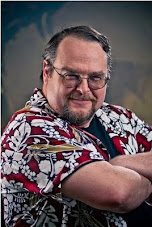 Universe.
Universe.
[1.0] Game Description
[2.0] Character Creation
[3.0] Character Role
[4.0] Recognition of Cool Things in the Game
[4.1] Cool Map
[4.2] Delta Vee
[5.0] Where it all went wrong
[5.1] Traveller Comparison
[5.2] Changing Nature of SF
[5.3] Modified Case Format
[5.4] How SPI didn't GET it
[6.0] More Later statement
[1.0] Game Description:
Universe was an attempt by wargamer publisher SPI (Simulations Publications Inc) to get into the increasingly dominant role-playing wing of the hobby industry. It came out the year after the more successful
Dragonquest, and shortly before the company was purchased by TSR. While
Universe did not kill SPI, it did little to provide the much-needed rescue, and it remains one of the worst games I've ever played (yes, I called out
Synnibarr and
Spawn earlier, but I can cheerfully admit that I never played them, their awfulness being clear to all at the first blush).
[2.0] Character Creation
I think the big reason for this failure is a character creation system that reads like a tax form and takes about as long to fill out. I think I spent a couple afternoons putting together a character, as I had to deal with matters like the gravitational force on my home planet in order to determine my abilities (sorry, potentials). It was big on formulae, and had more granularity than a beach in Hawaii.
[3.0] Character Role
The greater problem is what did you do once you had your character. The universe of
Universe was a very small place. I don't remember any obvious theme or metaplot or even long-term history that gave me factions or opposition or sense of purpose. There was a lot of low-level combat (ship-to-ship or personal melee level) but nothing that seemed to pull everything together. After a few rounds of combat, everything went back into the box and eventually passed out of my life.
[4.0] Recognition of Cool Things in the Game.
But the game did have some cool things to it.
[4.1] Cool Map
It had a cool map, showing real-space around our the Sol System, and should have been a great launching point for earth-centered campaigns.
[4.2] Delta Vee
Its space combat game was also pretty nice, and was inserted into an issue of Ares magazine. It tried to deal with the reality of space combat and setting vectors and thrust as opposed to transposing WWI dogfights into space. I think it still had, as Spock would say, "two-dimensional thinking", but it was playing to SPI's strengths there.
[5.0] Where it All Went Wrong
So what went wrong?
[5.1] Traveller comparison
If
Chivalry & Sorcery was an attempt to "Fix" D&D and make it more historically accurate,
Universe was an attempt to bring more hard science to bear against
Traveller, which was the SF roleplaying paradigm. Unfortunately, most people would put
Traveller on the harder end of a spectrum that includes both
Star Frontiers and
Star Wars, so flanking on that the science end made it appear even dryer than it was.
[5.2] Changing nature of SF.
The game also came out post-
Star Wars and post-
Empire Strikes Back, and with it we saw the popularization of more "space fantasy" than the harder popular SF of, say,
2001. The New Wave had opened up another front on the old "Rivets and blasters" school of SF, and Cyberpunk was just about to break loose. Not a place for a "traditional" SF game, especially one that was also avoiding that old-school "Buck Rogers" stuff as well.
[5.3] Modified Case Format
Most damaging to the case, I think, was the way the rules were presented in a structure called case format (or to be more accurate- modified case format). This was an outline form that you could summarize easily at the start, and made it easy to find complex rules relatively quickly. However, it bled the life out of the game itself, stood in the way of people getting to play the game, and occupied a lot of space (particularly as all headings are repeated, and master headings need text underneath them), so that the rules got longer and more intimidating.
[5.4] How SPI didn't GET it.
Universe is used as an example of how SPI, a wargaming company, just didn't GET RPGs and somehow deserved its fate as TSR took command of the gaming hobby. Yet
Dragonquest was actually pretty good, and where the company was comfortable with its subject matter it did quite well - its
War of the Rings was a good simulation of the LOTR Trilogy, and
Freedom in the Galaxy had that goofy
Star Wars feel of Empire versus Rebels (plus the greatest bad-girl name in histroy -Thysa Kimbo). Ultimately,
Universe's format, presentation, and lack of purpose created a joyless game. With a little work, it could produce something interesting and rewarding, but I could say the same of a bookcase from IKEA. That's why I put it down as one of the worst games I've ever truly played.
[5.5] More later statement
More later,
ERRATA: [5.5] More later statement should be
[6.0] More later statement.

























